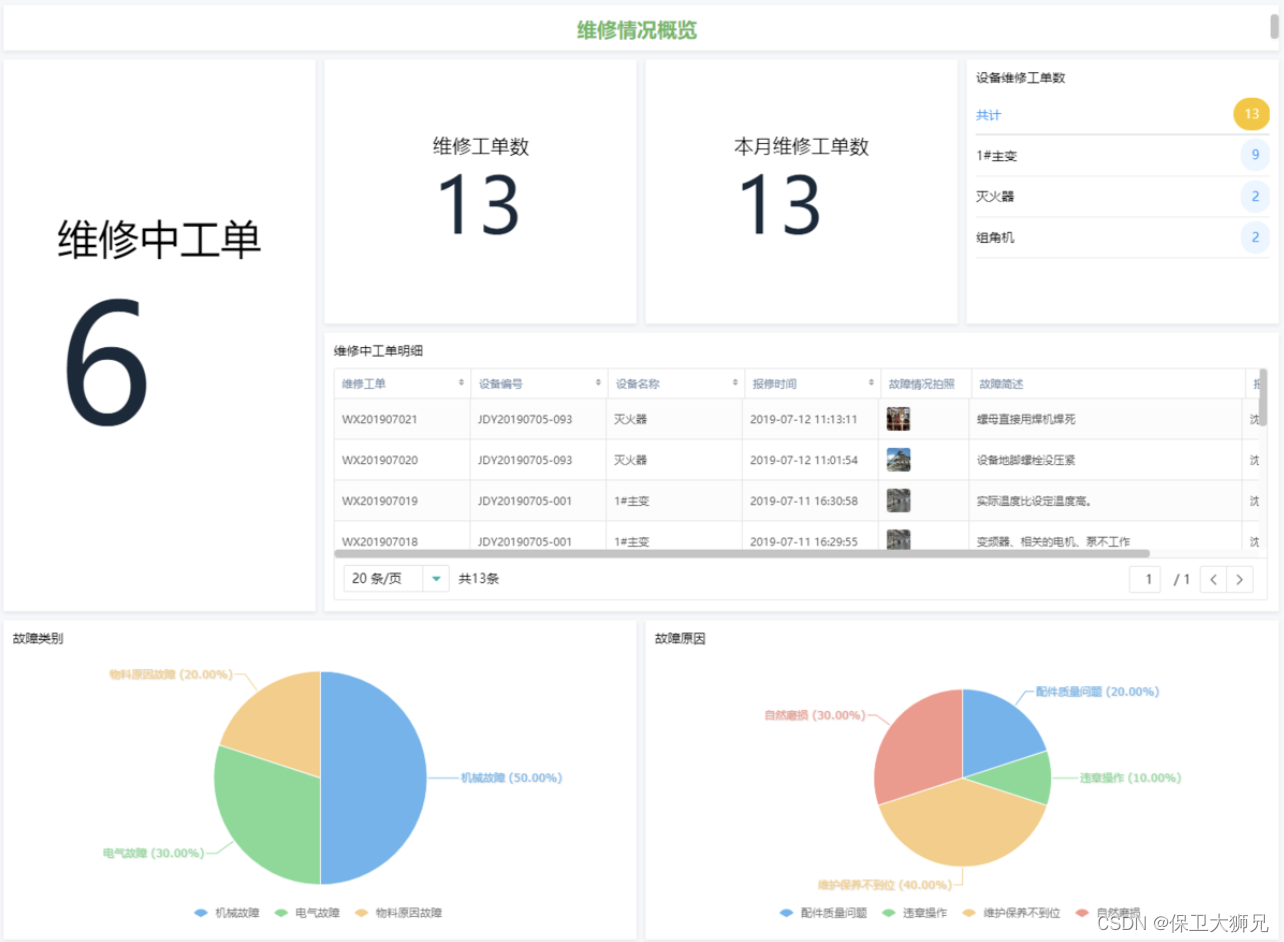This article will explain to you: What is the content of equipment inspection? Inspection precautions and inspection points?
Every manufacturing company has hundreds or thousands of equipment that require regular inspections. In manufacturing and processing enterprises, equipment inspection, repair and maintenance work is one of the important aspects to ensure production safety and efficiency. In the past, there have been numerous incidents of companies shutting down production due to missed inspections of defective equipment, causing huge losses to the company.
How to ensure the quality of inspections, improve the efficiency of inspections, and realize information management of the entire life cycle of equipment?
Next, I will explain the specific content of equipment inspection based on the equipment management and inspection system built by our company——
- What are the four major pain points of equipment inspection and how to solve them?
- How do companies transition to the new inspection model?
- Excellent implementation case sharing
Device Management Solution>>>>https://www.jiandaoyun.com (Ready-to-use, Can be built by yourself)
Before using the equipment management and inspection system, Company A's equipment management and inspection work had been in a very chaotic state:
- Frontline inspection workers use paper documents to record inspections, inefficiency, errors and missed inspections It’s a common occurrence;
- The superior department lacks effective means to regulate inspections, and supervision and management are not in place.Only inspections but no inspectionsThe phenomenon is serious;
- Paper data needs to be manually entered into Excel tables, sharing is inconvenient, and statistical summary is time-consuming and time-consuming force;
- The management teamis unable to obtain timely information on the operation status of the equipment, and the current status of equipment management is chaotic, causing great trouble to production management.
After some selection and comparison, Company A finally moved its equipment inspection business to the zero-code platform JDY. Through a series of technical means and data analysis, it created a new situation for the company's equipment management.
Pain point 1: Paper inspection efficiency is low
❌past
Paper inspection is undoubtedly the source of management inefficiency. The inspection content of different equipment is different. Inspection workers often miss inspections and make mistakes when filling out the forms. Signatures and times can be forged, making "fake inspections" unavoidable. Inspection work completely relies on workers' consciousness and sense of responsibility. This management method is obviously inadequate.
Thousands of equipmentInspection data piles up like a mountain, and just entering the data into Excel every month is cumbersome.. . Once the administrator inquires about the history of a certain device, data query and sharing are extremely inconvenientSummary statistics are time-consuming and labor-intensive
For the maintenance department, when a problem occurs, they need to know the history of the equipment. Using Excel is very inconvenient. It requires opening many tables and looking back and forth, and there is no way to gather them together. For management, they more often want to see aggregated results. Using Excel to summarize and analyze data is very time-consuming and inefficient, and cannot meet the need for viewing at any time.
✅Now
The equipment inspection solution of the zero-code platform supports the use of custom printing template functions to generate exclusive equipment QR codes for each equipment in the company, print them into equipment nameplates and post them on the equipment.

Workers only need to scan with their mobile phones, and the basic information corresponding to each device will automatically appear. You can also add the equipment's operation manual for reference by operators, or set up related queries. The equipment's recent inspections, repairs, maintenance, spare parts collection, and equipment photos will be automatically displayed after scanning the QR code. Workers can click on the corresponding page according to different tasks. The new button jumps to billing, and inspection, repair, and maintenance billing are all accessible with one click.
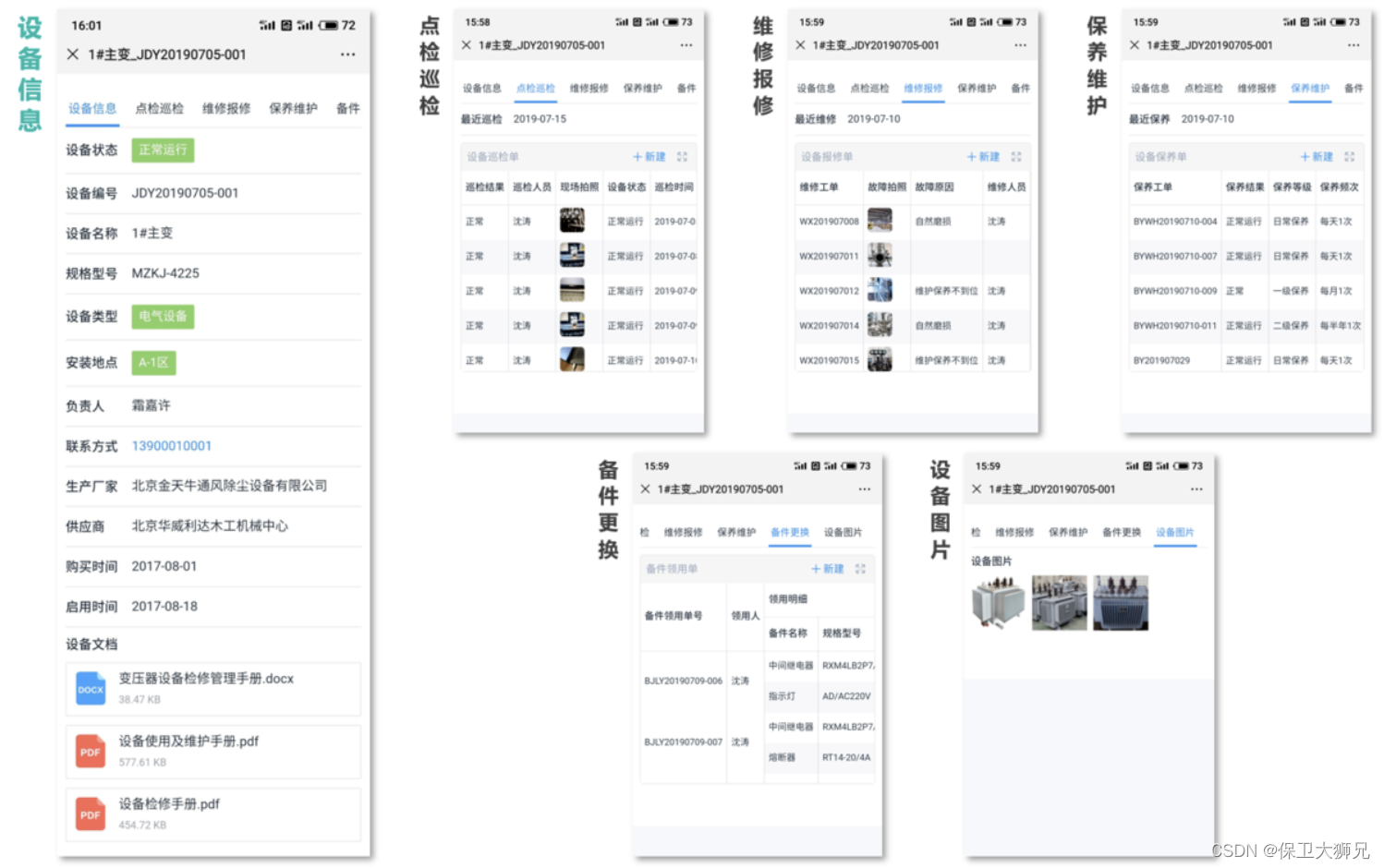
Then set up different inspection plans for different equipment. Relying on subform data linkage, workers can create inspection orders every time. The inspection plan corresponding to each piece of equipment appears automatically. Workers only need to check one by one according to the plan and select the inspection results. The operation is convenient and simple, and inspections will never be missed again.
And after this upgrade, workers can directly choose to create a new repair order in the inspection form after discovering a fault, simplifying the repair operation steps and reporting for repair with one click.
At the same time, the functions of GPS positioning and photo watermark sign-in are used to ensure the authenticity and reliability of the data,to eliminate "fake inspections". After data is submitted, it is automatically uploaded to the cloud, eliminating the need for manual aggregation and sorting, and easily solving query and sharing problems.

The QR code method is very suitable for on-site equipment management, which greatly simplifies data query, sharing and summary statistics, and helps enterprises achieve standardized and lean management of equipment.
Inspection data is updated in real time through the dashboard, and management can check the status of equipment that has been inspected and pending inspection on computers and mobile phones at any time, making supervision and management easy and efficient. The circulation and sharing of data no longer requires repeated communication between multiple personnel across departments. What data is needed can be easily found on the system.
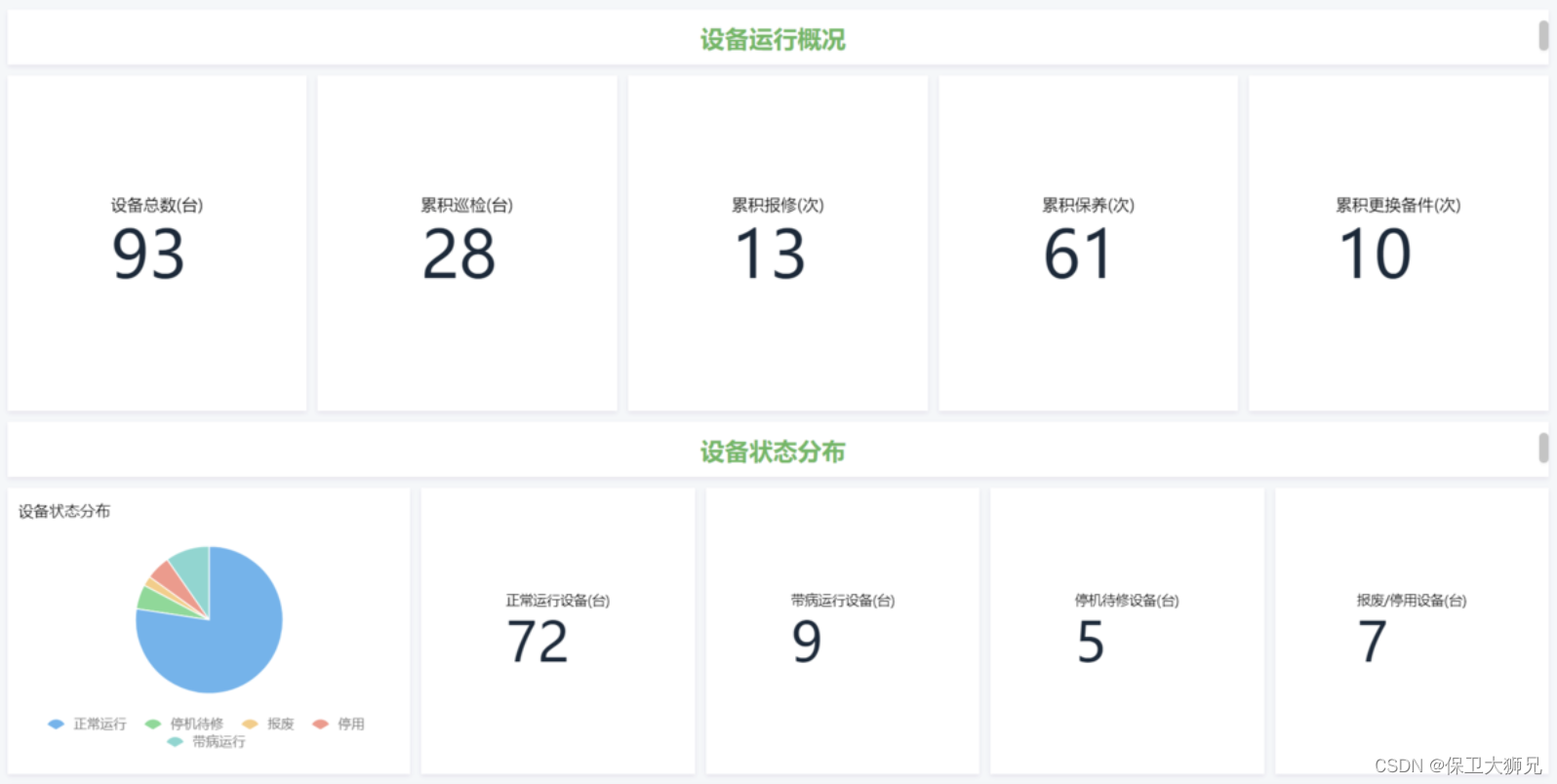
Pain point 2: Slow response to fault reports and repairs
❌past
The purpose of inspection is to promptly detect equipment abnormalities, quickly take maintenance measures, nip equipment hazards in the bud, shorten fault repair time, ensure stable operation of equipment, and minimize the impact on production progress.
In the past, when equipment malfunctioned, workers had to call to report for repair. The maintenance personnel went to the site to conduct a preliminary investigation and then reported it to the supervisor for further processing. The whole process wasted a lot of time, and< a i=1>The maintenance process and results are also difficult to monitor. Frequently, fault descriptions are inaccurate, response to dispatch is not timely, and no records are taken after repairs are completed. There is no corresponding equipment maintenance file, which is missing an important link in equipment life cycle management.
✅Now
The equipment repair reporting process is built through the zero-code platform. If an equipment abnormality is found at the production site, workers can directly take out their mobile phones to scan the equipment code to initiate the repair reporting process, take photos and videos of the fault, describe the fault content through voice, and submit it to the maintenance department for processing.
The maintenance supervisor receives the reminder and can determine the fault situation based on the photos and videos, and directly selects the relevant maintenance person in charge to dispatch the order. For example, electrical faults are handed over to the personnel responsible for electrical maintenance. Compared with the previous method of calling for repairs, the efficiency of repair reporting and maintenance has been greatly improved.
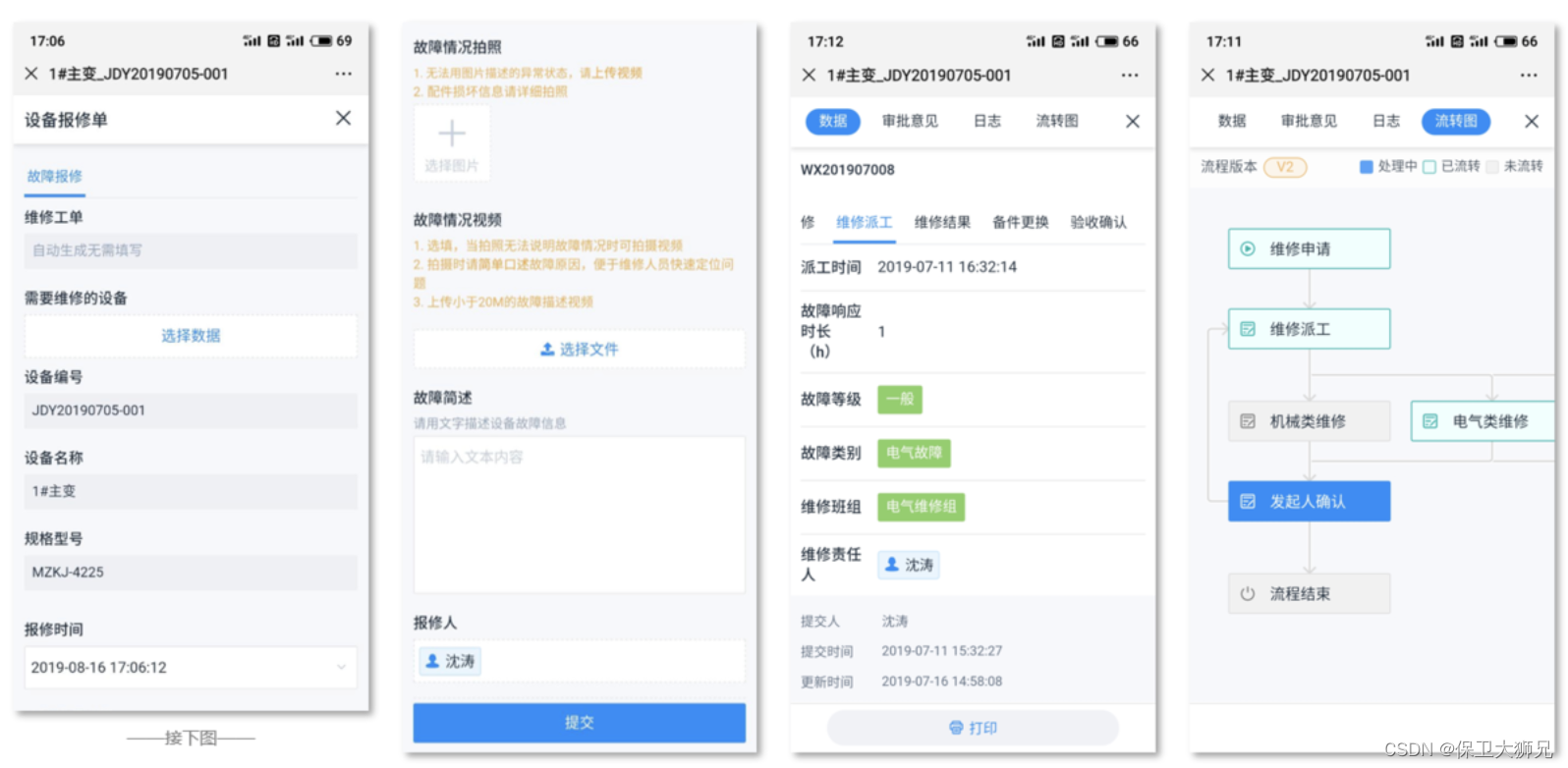
The system makes the maintenance progress transparent, and it is clear where the process is stuck and who is responsible. Maintenance processes become traceable, better connecting equipment and maintenance personnel. Equipment failure maintenance analysis tables and maintenance employee performance statistics tables can also be automatically generated through the zero-code platform, truly realizing digital management.
Pain point 3: Difficulty in executing maintenance plans
❌past
The natural life span of equipment depends to a large extent on the quality of maintenance work. Maintenance once a month, minor repairs once every quarter, and major repairs once a year are undoubtedly a huge workload when facing thousands of devices. In the past, the company lacked a systematic plan forequipment maintenance. The equipment department formulated maintenance tasks in writing, and thedistribution and execution process were negligent. Control, maintenance records are always missing…
This series of problems makes equipment operation full of risks. There are no powerful tools to supervise workers to perform maintenance. Once an accident occurs, the company will not only have to bear the loss of equipment, but more seriously will have an impact on production efficiency and progress.
✅Now
Build an equipment maintenance module on the zero-code platform. As long as the manager enters the maintenance plan, maintenance tasks will be automatically generated when they are due, and the relevant person in charge will be automatically reminded to perform them. Regular reminders and maintenance calendars will ensure that tasks will never be forgotten and the maintenance status will be clear at a glance. .
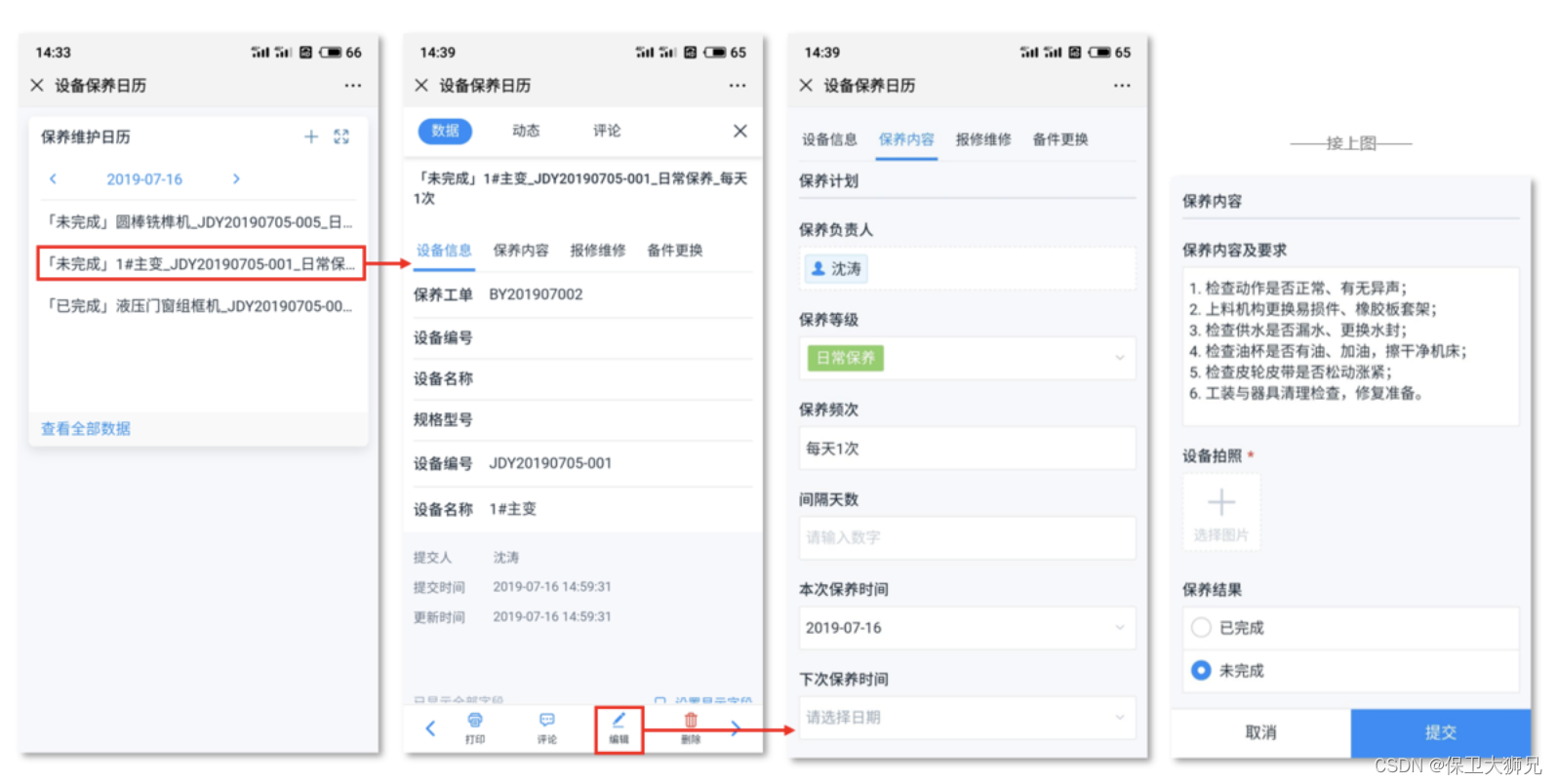
For example, if you need to perform first-level maintenance on the equipment every month, you only need to set the execution frequency in the "Equipment Maintenance Schedule" to once a month, select the maintenance person in charge and the planned maintenance time, and the system will automatically set the execution frequency in the "Equipment Maintenance Schedule" A piece of maintenance task data is generated in the system, and the corresponding person in charge is automatically reminded to perform maintenance work on the maintenance date.
After completion, the system will automatically calculate the next maintenance date based on the maintenance cycle, and generate tasks again in a cycle, making complex equipment maintenance management simple and efficient.
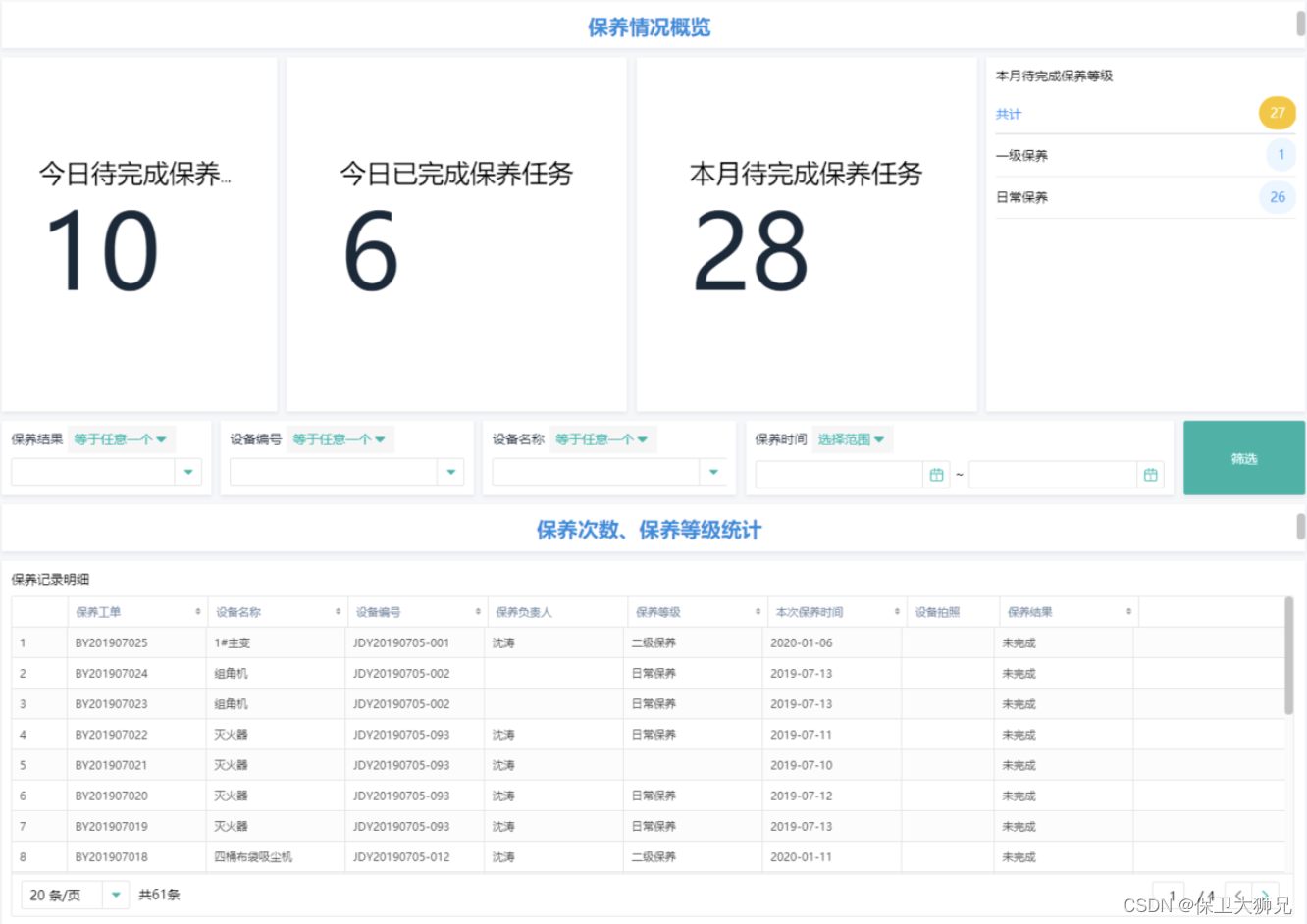
Pain point four: Equipment file management is chaotic
❌past
Equipment inspection, repair, and maintenance records are all important components of equipment files. In the era of paper management, equipment files are just a pile of "waste paper". Not only are the records incomplete, but the forms are also separated.There is no correlation between the data, If you want to systematically search for the historical inspection, repair and maintenance records of a piece of equipment, it is like looking for a needle in a haystack.
The disadvantages of paper data are obvious:Data cannot be fully utilized, difficult to share, easy to lose, and the cost of subsequent maintenance is extremely high…if there is no equipment Files, so where do we start talking about device management?
✅Now
Use the dashboard of the zero-code platform to create device files and solve all the above problems. The basic information of the equipment, inspection records, repair records, and maintenance records are summarized and presented on the same dashboard, and the entire process of the equipment from installation and use to scrapping is recorded. Once an abnormality occurs in the equipment, the complete equipment files can be viewed at any time through mobile phones and computers to help analyze and solve the problem.

From 0 to 1: How do companies transition to the new inspection model?
The above mentioned many benefits of new inspection applications, so here comes the key point——
For an enterprise that has never used an inspection application, how does it transition to a new inspection model? How long does it take approximately?
If you want to implement it as soon as possible, it is recommended to break it down into the following six steps:

(1) The enterprise administrator clicks to install the "Equipment Management and Inspection" application (Administrators can refer to the help center to add/delete/modify functions)
Estimated installation time: 5 seconds

(2) The administrator enters the equipment information in the equipment ledger table (If there is an excel version of the equipment ledger, the data can be imported directly)
Estimated entry time: 5 seconds per entry manually
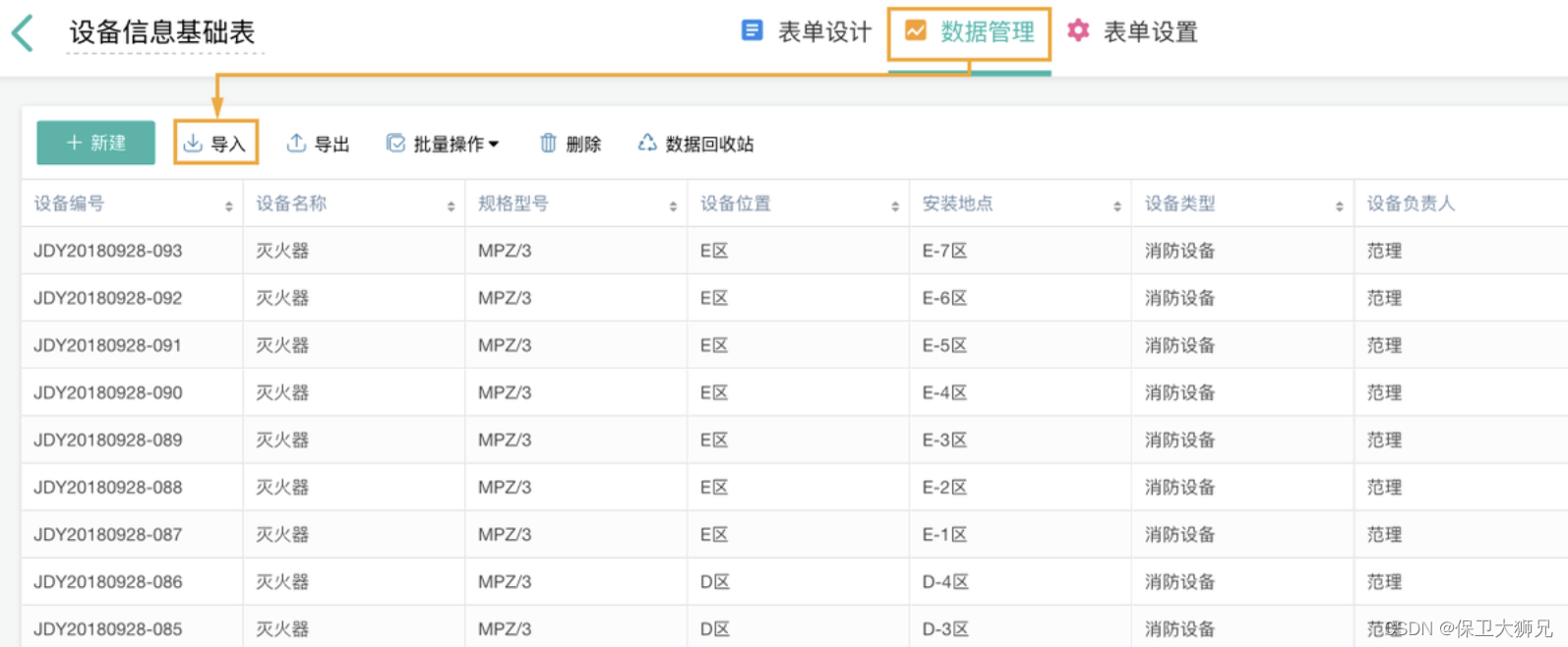
(3) The administrator prints the inspection QR code and the equipment information QR code, and sticks the QR code on the corresponding device
Estimated posting time: 5 minutes/device

(4) The administrator invites the inspector to join the team, and assigns the application to the corresponding personnel according to permissions (such as sharing the inspection list and maintenance list with the inspector, Share analysis reports with managers)
Estimated overall time: 5 minutes

(5) Teach inspectors and maintenance personnel how to use two forms (Equipment Inspection Form + Equipment Repair Form)
Estimated teaching time: 10 minutes/person

(6) Announce the usage time of the new inspection mode and start its implementation
After many tests, in ordinary small and medium-sized enterprises, this application can be officially launched within one day. If you encounter any problems during use, you can find the contact information for product operations in this application template to discuss and optimize together until the company successfully transitions to the new inspection model.
Excellent implementation cases
This manufacturing company has achieved satisfactory results with its equipment management and application!
With the continuous development of automation technology in Yongrui's production workshops and the adoption of more and more imported equipment, Yongrui began to focus on optimizing traditional equipment management methods and doing a good job in preventive maintenance management of equipment.
Through the "Equipment Management and Inspection System" built on the zero-code platform, Guangdong Yongrui Industrial Co., Ltd. has now implemented a management model of inspection, repair, maintenance automation and equipment information digitization, and has achieved good results in many aspects:
- The equipment QR code replaces the traditional billing method and realizes paperless management, which is green, environmentally friendly, fast and efficient.
- Innovated the inspection check-in method to ensure that inspections are completed on time and at fixed points, improving the efficiency and quality of inspections
- After the repair order is submitted, the system automatically dispatches the order, optimizing the reporting procedures, saving intermediate processes, and improving maintenance efficiency.
- Digital management is realized through Kanban, and data processing such as equipment operation status and team performance evaluation are more refined.
1. Generate device-specific QR code
Traditional equipment management is accustomed to using paper documents, but Yongrui sets up custom printing templates, generates QR codes within the form, and affixes exclusive QR codes to each device.
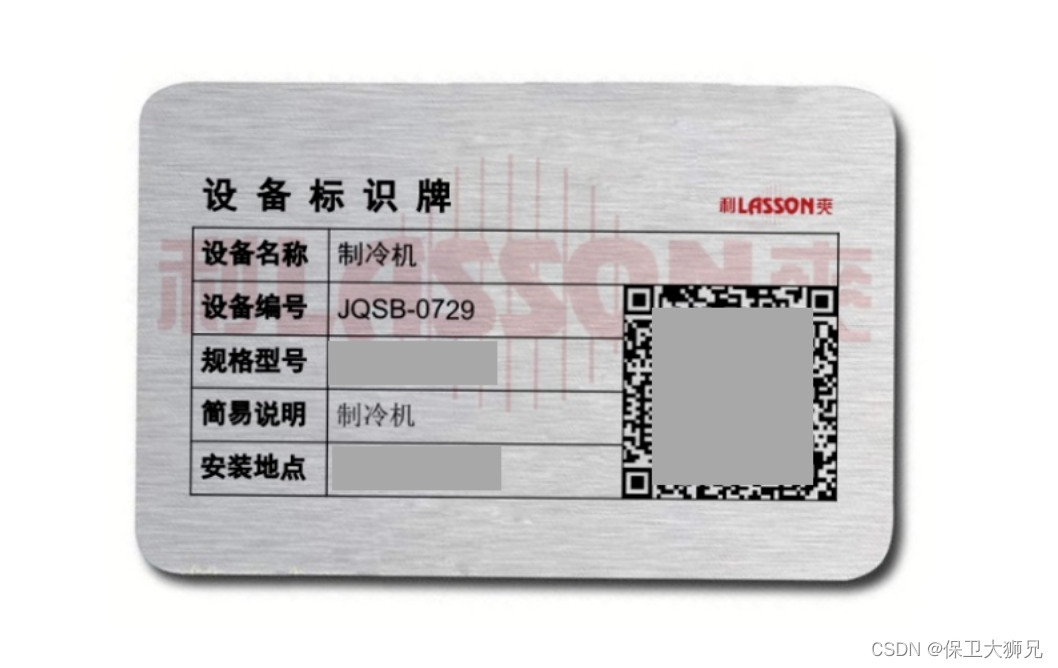
During inspection, employees only need to go to each piece of equipment and turn on the QR code scanning function on their mobile phones to obtain information about the corresponding equipment and fill out the inspection work order.

2. Inspection, positioning and taking photos, each time is well-documented
How to avoid inspection errors and omissions is one of the problems that plagues many companies.
Through the inspection system, Yongrui has set up positioning and picture upload functions in each inspection form. After starting the inspection, inspection personnel can automatically obtain positioning, submission date and other information, and upload watermarked photos according to standards to ensure that every All inspections are true, effective and well-documented.
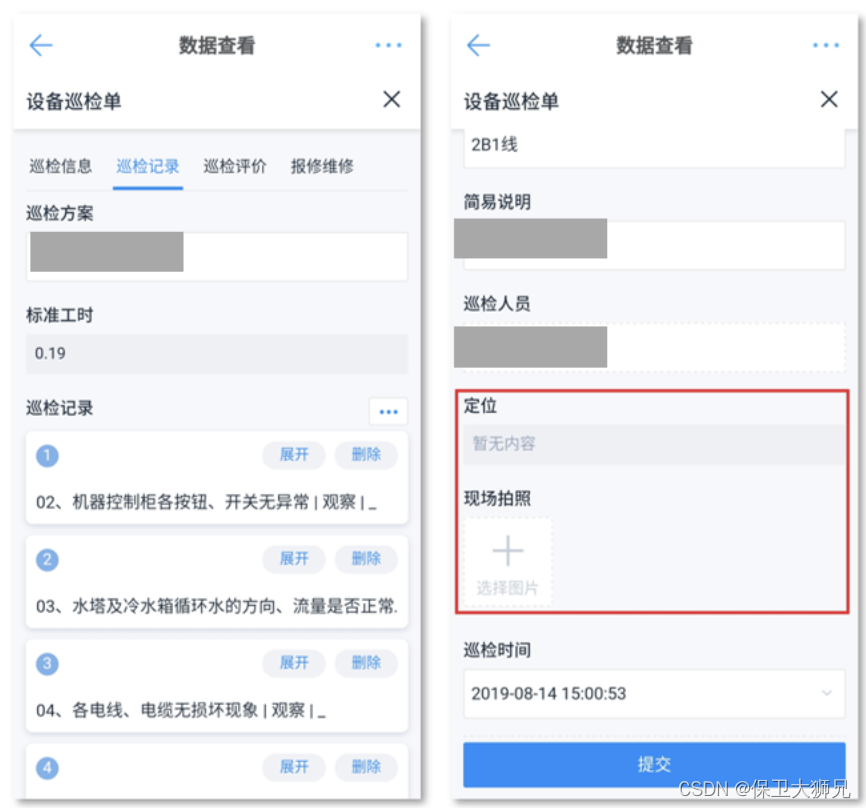
3. Report repairs online and automatically dispatch orders
In order to optimize the repair process and ensure equipment safety, Yongrui has designed the process form of [Equipment Failure Repair] in advance in the inspection system to achieve:
When an equipment malfunction occurs, the inspector immediately scans the QR code of the equipment and fills in and submits the repair information. Based on the built-in process, the system automatically determines the repair time and the maintenance personnel's on-duty status, and delivers the maintenance request to the corresponding maintenance personnel in real time. The maintenance personnel can open the repair notification to view equipment failure and other information, and handle it quickly.
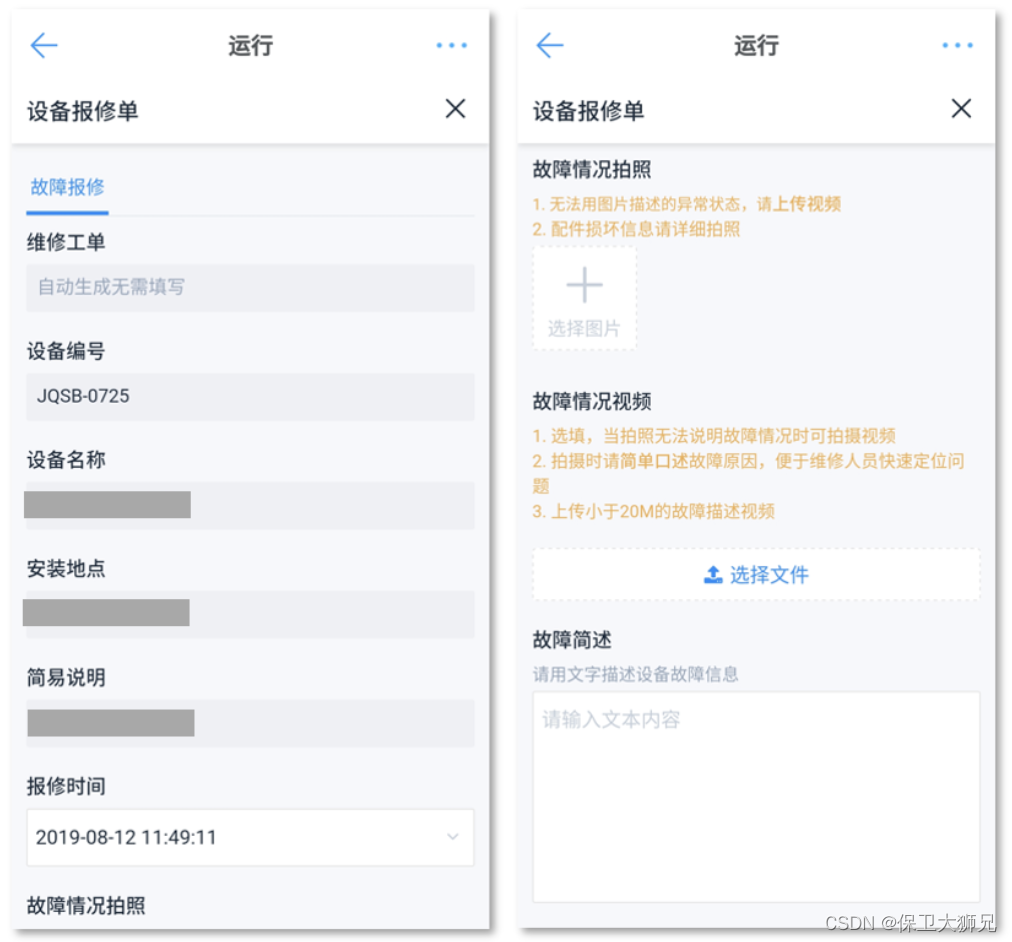
4. Digital signage to manage equipment in an orderly manner
Digital equipment management can manage many enterprise equipment in an orderly manner, further summarize and analyze data, and enable managers to understand frontline work conditions.
Yongrui builds an [Equipment Maintenance Statistics] dashboard through the dashboard to summarize all inspection and maintenance records, equipment life cycle records and other equipment files in real time, and automatically generates data reports and analysis charts.
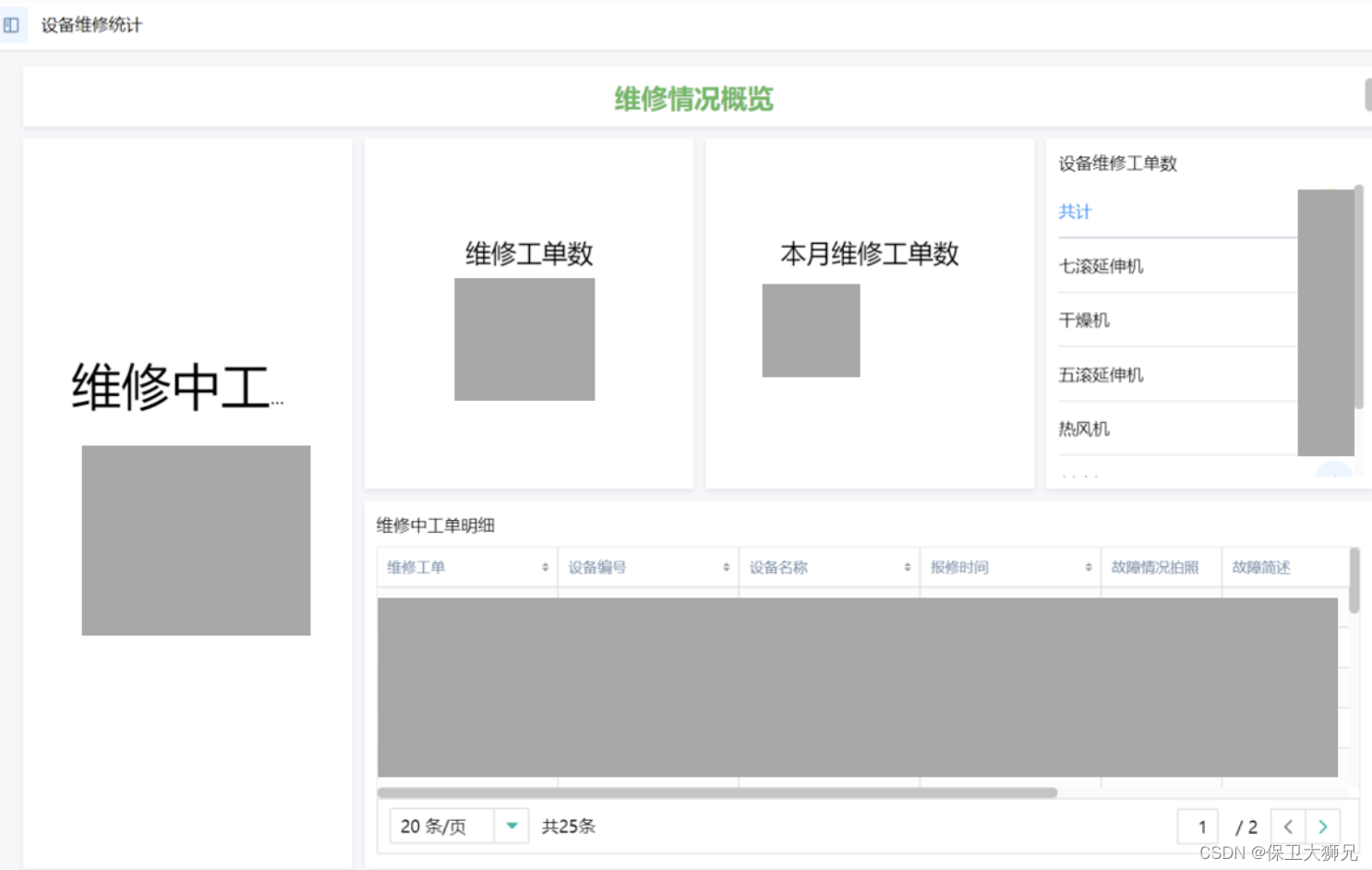
At the same time, Yongrui has built a [Maintenance Calendar] and [Maintenance Statistics] dashboard to facilitate maintenance staff to check the items to be maintained on their mobile phones, and managers can follow up on the machine maintenance progress at any time to achieve preventive management of machinery and equipment.
In order to optimize employee performance appraisal work, Yongrui has also added a [Manager Evaluation] section to equipment inspection, repair, maintenance and other processes. The manager comprehensively judges the completion degree of each work order based on the corresponding indicators to conduct evaluation; the system then directly calculates the performance score based on the relevant parameters.
For many traditional manufacturing companies, the road to informatization transformation is long but inevitable. Equipment and production are closely related. Smarter equipment management can provide managers with a visual information window, use data to provide a basis for production decisions, and reduce risks and failure rates. From the perspective of equipment management alone, as long as it can improve personnel efficiency and reduce internal consumption of the enterprise, it is creating value for the enterprise.
The above is an explanation about what is included in the equipment inspection as well as the inspection precautions and key points. I hope it will be helpful to everyone!
